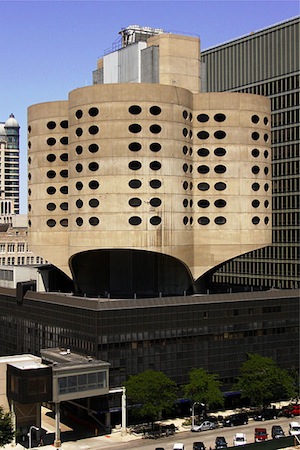The National Trust for Historic Preservation and Landmarks Illinois have dropped a lawsuit alleging that the city of Chicago improperly denied landmark status to Prentice Women's Hospital, an iconic modernist structure designed in the 1970s by Bertrand Goldberg. Owner Northwestern University will now be free to go forward with its plan to build a major new biomedical research facility on the downtown site.
The Prentice demolition has been under dispute for several years, as preservation enthusiasts attempted to make the case that the building, with its quatrefoil concrete shell cantilevered over a narrow core, was worth saving. Last November, in contentious proceedings, the Commission on Chicago Landmarks granted the building landmark status and then removed the designation on the same day.
After a hearing in Cook County Circuit Court, the preservation groups decided not to proceed. "We continue to believe there were significant flaws with the process that granted and then removed landmark protection for Prentice," said the National Trust in an official statement. "However, we feel that the landmarks process has run its course."
National Trust Field Officer Christina Morris said the groups will continue to cooperate with the city on preservation of historic structures, and that the Prentice situation has brought important attention to the role of modernist architecture in the U.S. “We will continue to work with our partners to preserve the best of Chicago’s architectural heritage.”
(http://www.chicagotribune.com/news/local/breaking/chi-lawsuit-dropped-over-prentice-preservation-20130214,0,3552305.story)
Related Stories
| May 3, 2014
Health system capital planning for the future: The benefits of master plan portfolio analysis and ambulatory market modeling
Money continues to be scarce, yet U.S. health systems need to invest and re-invest in their physical future. Healthcare facilities planning experts from CBRE Healthcare outline tools and strategies for identifying where to best allocate precious resources.
| May 1, 2014
Super BIM: 7 award-winning BIM/VDC-driven projects
Thom Mayne's Perot Museum of Nature and Science and Anaheim's new intermodal center are among the 2014 AIA TAP BIM Award winners.
| Apr 29, 2014
USGBC launches real-time green building data dashboard
The online data visualization resource highlights green building data for each state and Washington, D.C.
| Apr 16, 2014
Upgrading windows: repair, refurbish, or retrofit [AIA course]
Building Teams must focus on a number of key decisions in order to arrive at the optimal solution: repair the windows in place, remove and refurbish them, or opt for full replacement.
| Apr 9, 2014
How patient-centered medical homes can help healthcare providers and patients
Beyond reducing the number of uninsured Americans, the Affordable Care Act is driving new types of healthcare facilities, especially patient-centered medical homes.
| Apr 9, 2014
Steel decks: 11 tips for their proper use | BD+C
Building Teams have been using steel decks with proven success for 75 years. Building Design+Construction consulted with technical experts from the Steel Deck Institute and the deck manufacturing industry for their advice on how best to use steel decking.
| Apr 2, 2014
The new model of healthcare facility management
A growing number of healthcare organizations are moving to an integrated real estate model in an effort to better manage costs, respond to regulatory requirements, and support changes in patient care delivery.
| Apr 2, 2014
8 tips for avoiding thermal bridges in window applications
Aligning thermal breaks and applying air barriers are among the top design and installation tricks recommended by building enclosure experts.
| Mar 26, 2014
Callison launches sustainable design tool with 84 proven strategies
Hybrid ventilation, nighttime cooling, and fuel cell technology are among the dozens of sustainable design techniques profiled by Callison on its new website, Matrix.Callison.com.
Sponsored | | Mar 25, 2014
Johns Hopkins chooses SLENDERWALL for a critical medical facility reconstruction
After decades of wear, the hand-laid brick envelope of the Johns Hopkins nine-story Nelson/Harvey inpatient facility began failing. SLENDERWALL met the requirements for renovation.
















